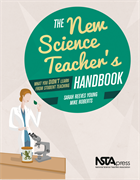Just in Time: The New Science Teacher's Handbook
By Carole Hayward
Posted on 2013-09-21
 As a new science teacher, your first year of teaching is well underway. You’ve been facing the challenges that all new teachers face—learning your students’ names, how to manage your classroom, the best ways to engage your students, and how to account to your administrators for all that you do. But science teachers face other challenges, such as additional safety requirements, particular grading difficulties, budget restrictions, and how to incorporate science into an already crowded curriculum.
As a new science teacher, your first year of teaching is well underway. You’ve been facing the challenges that all new teachers face—learning your students’ names, how to manage your classroom, the best ways to engage your students, and how to account to your administrators for all that you do. But science teachers face other challenges, such as additional safety requirements, particular grading difficulties, budget restrictions, and how to incorporate science into an already crowded curriculum.
The New Science Teacher’s Handbook: What You Didn’t Learn From Student Teaching may be just the lifeline you need to keep your first teaching experience a positive one. Written by Sarah Reeves Young and Mike Roberts, using their actual classroom experiences as examples, this handbook tells you what you need to know that you didn’t learn in your preservice training.
Each chapter presents scenarios and time-tested ideas from both within and outside the classroom. The authors explain the setup for each chapter:
The Story: These are actual experiences that happened within either Sarah’s or Mike’s classroom. Any “I” statements are in reference to what happened to us individually within our classrooms. As a new teacher, it’s always nice to know that someone else has had a similar struggle. These true stories demonstrate that even those who go on to write books on best practices in the classroom didn’t start off as perfect educators.
The Moral: What we learned from the aforementioned story. Similar to a fable, there is a moral to each story that addresses the theme of the struggle and sets the stage for moving beyond the challenge.
Steps for Success: Here we present strategies to help teachers overcome situations similar to those presented in “the story.” There are multiple solutions presented so teachers can choose those that work best for their specific concerns and school environment.
What Does Success Look Like: This section examines how the classroom looks after implementing the “steps for success.” This is the “light at the end of the tunnel” to help new teachers see that common challenges can end with positive results that benefit both teacher and students.
Resources: Here we present resources to consider for additional support in organizing the classroom for those teachers who want to explore the topic in more detail.
Whether you are on your way to becoming a new science teacher or a teacher in the early years of your career, we feel confident that the ideas presented here will help you become the teacher you’ve always wanted to be.
To learn more, check out the sample chapter: “Starting Class the Right Way: Starter Activities.” This book is also available as an e-book.
An additional NSTA Press resources to help you as you get started in your science teaching career is Rise and Shine: A Practical Guide for the Beginning Science Teacher.
Disclaimer: The views expressed in this blog post are those of the author(s) and do not necessarily reflect the official position of the National Science Teaching Association (NSTA).


